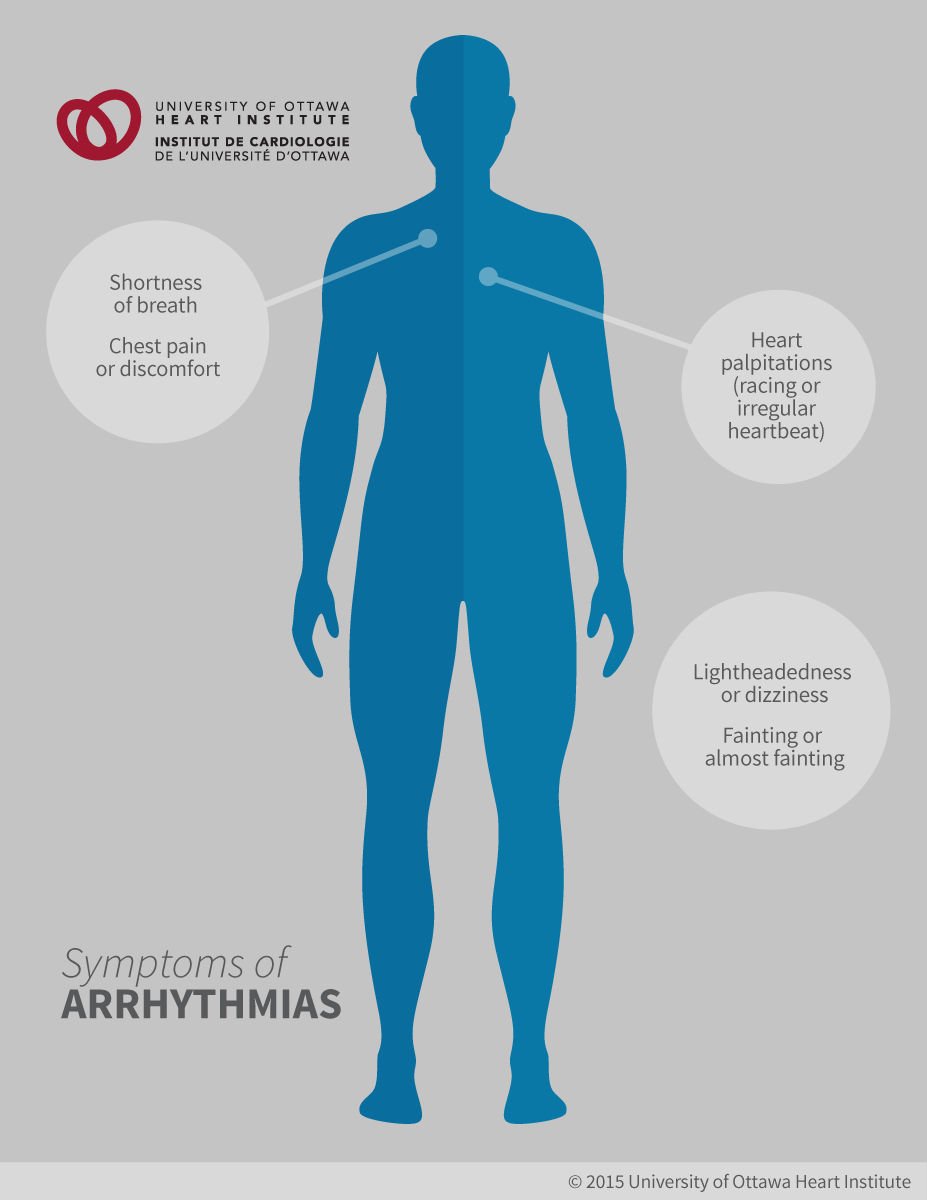
The heartbeat is controlled by electrical impulses that normally travel on a smooth path through the heart, causing the ventricles and atria to contract in a specific order, pushing blood through the lungs and body. These electrical impulses are controlled by the heart's sinoatrial (SA) node, or sinus node, the heart's natural pacemaker.
Although many arrhythmias will never cause health problems, they can cause troublesome symptoms, such as dizziness or chest discomfort. Other, more dangerous arrhythmias can impact blood supply and require medical management. Left untreated, they can eventually lead to stroke, heart attack, heart failure, or sudden death.
Atrial fibrillation (afib) is the most common arrhythmia. Different types of atrial fibrillation may last for seconds or be permanent. The condition is more common in older people and can have many different causes.
Ventricular fibrillation is the most dangerous type of arrhythmia. With this condition, the heart's ventricles lose the ability to contract, stopping blood flow to the body and brain. Ventricular fibrillation rapidly leads to loss of consciousness and death, and requires electrical shock (defibrillation) to restart the heartbeat.
On this page
Causes
Damage from many heart diseases and disorders can cause arrhythmias. These include:
- Coronary artery disease
- Past heart attack
- High blood pressure
- Valve disease
- Some forms of congenital heart disease or cardiomyopathy
Often, in patients with an arrhythmia, the heart is normal. Other diseases or substances that can cause arrhythmias include:
- Inherited (genetic) disorders such as Long QT Syndrome
- Diabetes
- Endocrine disorders, such as problems with the thyroid gland
- Excess alcohol and some street drugs
- Excess caffeine
- Smoking
- Some prescription medications or dietary supplements
- Stress
Diagnosis
Tests commonly used to diagnose arrhythmias include:
- Electrocardiogram: to identify problems with heart rhythm
- Holter monitor: a portable electrocardiogram machine used to continuously monitor the heartbeat over one or two days
- Event monitor: similar to a Holter monitor, but used for weeks or months. An event recorder is turned on by the patient when symptoms occur
- Electrophysiology studies: to track and stimulate electrical impulses in the heart
- Stress (exercise) testing: to test whether an arrhythmia occurs when the heart is challenged to work harder than normal
Symptoms
Symptoms of arrhythmias can include:
- Heart palpitations (a racing or irregular heartbeat)
- Lightheadedness or dizziness
- Fainting or almost fainting
- Shortness of breath
- Chest pain or discomfort
Many of these symptoms can be confused with the effects of aging or physical inactivity, or with other diseases affecting the heart.
Treatments
A variety of approaches can be taken in treating and managing arrhythmias. Some arrhythmias need only to be monitored, while others require urgent treatment.
Drug Therapies
Many drugs are available for reducing the occurrence of arrhythmias or managing symptoms. These include drugs to:
- Slow the heartbeat (beta blockers and calcium channel blockers)
- Keep the heart rhythm normal (antiarrhythmic drugs)
- Help prevent blood clots (blood thinners, such as warfarin)
Implantable Devices
Some people with arrhythmias may need an implantable device to help the heart work properly.
- A pacemaker is a small device implanted near the heart. It is usually used to treat bradycardia. The pacemaker monitors the electrical activity of the heart and delivers a small electrical pulse when the heart beats too slowly. For more information, see the Pacemaker Implantation Patient Guide.
- An implantable cardioverter-defibrillator (ICD) is similar to a pacemaker but can deliver an electrical shock to restore normal heart rhythms when needed. An ICD may be necessary for patients with more dangerous arrhythmias that can stop the heartbeat, such as ventricular fibrillation. For more information, see the ICD Patient Guide.
Ablation
Some arrhythmias may need to be treated with a minimally invasive technique called radio-frequency ablation. This procedure is performed using a catheter threaded through a blood vessel to the heart. An electrode is inserted through the catheter and used to heat and destroy a small area of tissue. This can block abnormal electrical signalling pathways in the heart.
Lifestyle Changes
Lifestyle changes can help reduce the symptoms of heart disease underlying arrhythmias as well as target arrhythmias directly. Some changes recommended for people with arrhythmias include:
- Quitting smoking
- Limiting alcohol, caffeine, and over-the-counter medications that contain stimulants
- Increasing physical activity (with a doctor's supervision)
- Reducing stress
- Losing weight if overweight and maintaining a healthy weight
Although important, such lifestyle changes may have little effect on arrhythmias.


